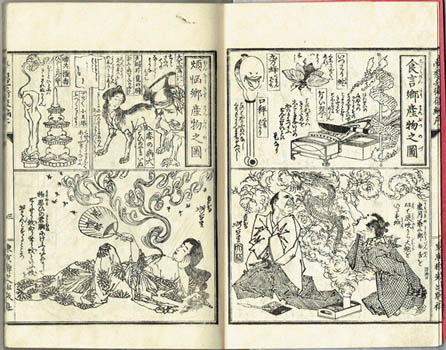
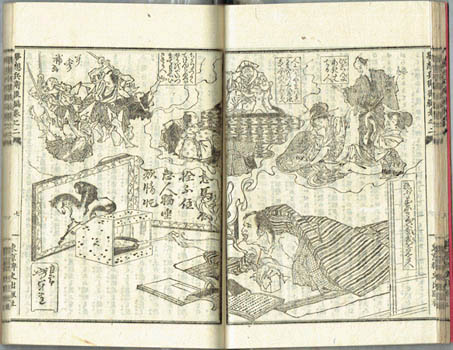
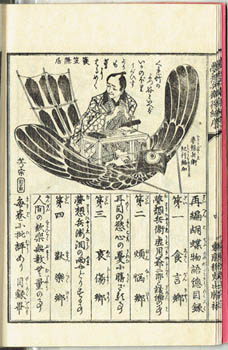
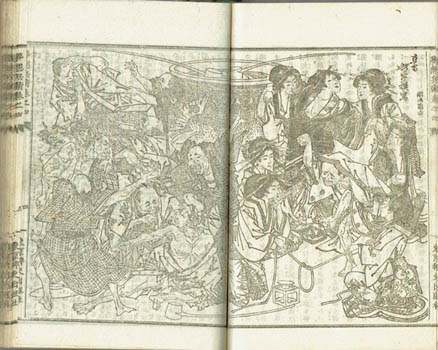

Kyokutei Bakin. [sometimes called Takizawa Bakin]. Yoshitoshi. [Muso byoe kocho monogatari - A Dreamer's Butterfly Tale]. Tokyo, Haishi Shuppansha 1882 [Meiji 15]. Two volumes 225x155mm, publisher's embossed yellow wrappers; a half-page, ten double page and five full page woodcut illustrations by Yoshitoshi. A tiny bit of nibbling to a couple of page edges, a good fresh copy. Au$450
Bakin's imaginary voyage fantasia was first published in 1809-10 and this is, I deduce, the second edition, revised or corrected from Bakin's own copy of the first edition; the first with Yoshitoshi's illustrations. Further editions followed thick and fast but apart from a partial translation in The Chrysanthemum (Yokohama 1882) I can't find an English version exists - particularly frustrating as Yoshitoshi's illustrations are magnetic. The surreal and grotesque are always hard to resist - and Yoshitoshi was a master among masters. I don't think I've ever seen a better illustration, a better description, of the world of an opium smoker.
The best account of the book I've found is in a 1909 letter from Minakata Kumagusu to the publisher Gowans & Gray who had approached him for a translation of a Bakin work of his choice. He chose this, "the only book that ever took me out of bed 30 minutes sooner than I wished to get up", and described it as something like Gulliver's Travels in which a man, decided there is nothing more to learn in his own land, determines to travel the world. He is told the means - a kite - in a vision and sets off to explore the lands of Infancy, Lust (high, medium and low grades), Drunkenness, Greed, Trouble, Sorrows, Falsehood and Happiness. Unfortunately Gowan & Gray wouldn't spring for Kumagusu's fee and that was the end of that. At least we have Yoshitoshi.
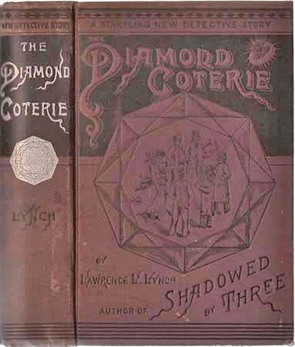
LYNCH, Lawrence L. [Emma Murdoch van Deventer?]. The New Detective Story. The Diamond Coterie. Chicago, Donnelley 1885. Octavo publisher's illustrated plum cloth blocked in black and silver (surface blotch on the back cover); numerous full page wood engravings (not without some crude appeal). Some natural toning of the paper but a rather good copy. Au$100
I'm not sure whether the mystery of the first edition of this book has ever been solved but I can tell you this isn't it. Copyright dates of 1882 and 1884 have led some bibliographers to the conclusion that there is an 1882 edition but I want to know who has seen one. There is an 1884 edition but I doubt the supposed Sumner 1884 edition cited by some really is 1884; my bet is on Donnelley 1884 being the first edition.
Emma van Deventer has been long established as Lawrence Lynch but I've come across recent questions about the existence of anyone called Emma Murdoch van Deventer. The publisher tells us that this "combines the excitement that ever attends the intricate and hazardous schemes of a detective ... with ... as carefully constructed and cunningly elaborated a plot as the best of Wilkie Collins' or Charles Reade's." This is not unreasonable, it certainly is elaborate.
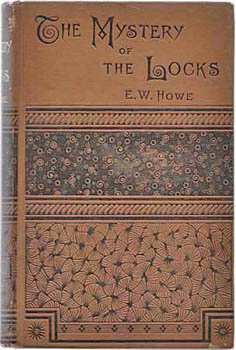
HOWE, E.W. The Mystery of the Locks. Boston, Osgood 1885. Octavo publisher's decorated brown cloth blocked in black and gilt. A small, almost tiny, snag at the top of the spine, a rather good, bright copy. Au$125
First (only?) edition. A fine array of gothic chapter headings if nothing else: The Town of Dark Nights; The Face at the Window; Pictures in the Fire; The Locks' Ghost; The Whispers in the Air; The Ancient Maiden; A Shot at the Shadow; The Step on the Stair; The Pursuing Shadow; ... and finally The Going Down of the Sun.
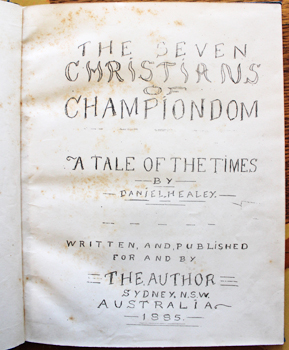

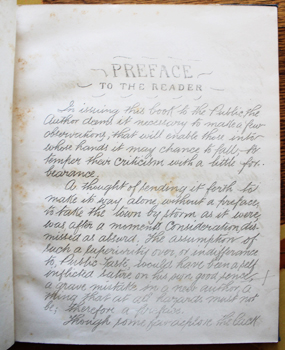

HEALEY, Daniel. The Seven Christians Of Championdom - A Tale of the Times. Written, and published for and by The Author, Sydney ... 1885. 26x21cm original half cloth & marbled boards with gilt on black title label (wear to tips and edges, label quite rubbed); 152pp. Printed from handwriting by some kind of duplication or autolithography. Bookplate recording its gift from John Lane Mullins to St Sophia's Library. Au$1200
Singular, eccentric ... all the usual labels apply to this distopian, or at least satirical, romance of the city of Yendis, capital of Champiana. Daniel Healey might be better known as author Whaks Li Kell but it's unlikely. That's the painful pseudonym he used for his other known book, 'The Cornstalk, his habits and habitats' (1893), in which his target expanded from Sydney to the colony of New South Wales.
This did receive a cruel notice in The Bulletin (August 1 1885) but it was written with a hand as heavy on the wit lever as Healey's by someone who would rather be cute than intelligible. It's hard to figure out exactly what the reviewer is mocking. Elsewhere I find a Daniel Healey was an unsuccessful independent candidate for the inner city seat of Sydney-Cook in 1898 and an unsuccessful Labor (possibly) candidate for Sydney-Bligh in 1901 - which sounds like our author - but there were a lot of Daniel Healeys.
How many copies of this were produced is unknown but I'd suggest the four copies found by Trove plus this one must be a noticeable percentage. The only copy I've found sold in recent decades was this same copy.
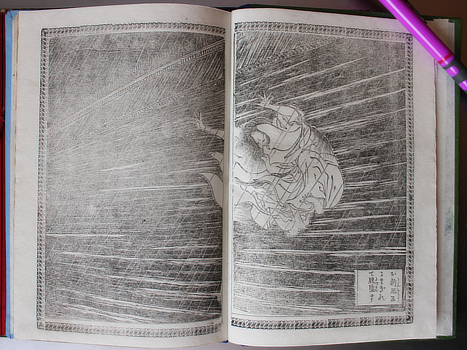
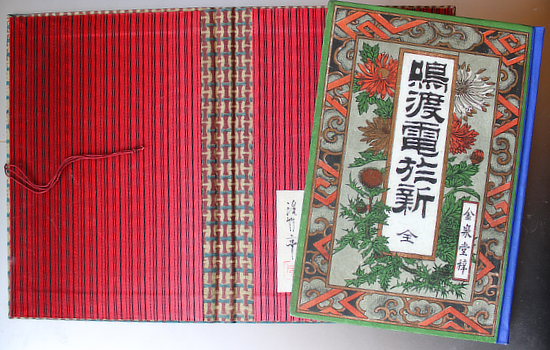
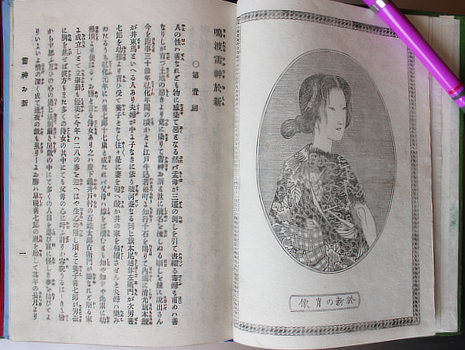
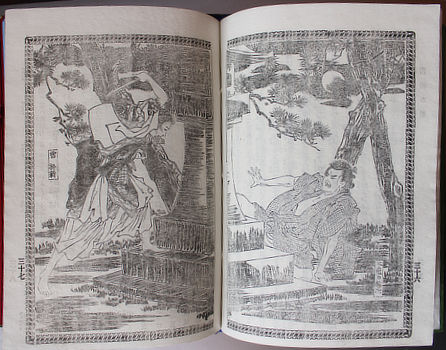

Ito Kyoto. [Naruto Kaminari Oshin ?]. Tokyo, Kinsendo 1886 (Meiji 19). 18x12cm publisher's colour illustrated boards with cloth spine; four illustrations, three double page. A fabulous copy in a chic case by binder, writer and fastidious collector Atsuo Ikuta. At first I thought this had somehow been recased with new endpapers but the whole book is on the same almost translucent paper and it all matches exactly a shabby copy I found illustrated. Au$500
This might appear to be the first edition but it turns out that an edition appeared in 1883 from a different publisher with different illustrations. This is the story of the tattooed woman desperado Kaminari (or Rai?) Oshin - Naruto Kaminari might translate as roaring or raging thunder.
This immediately reminds us of Benten Kozo Kikunosuke - the tattooed woman outlaw who was outed as a man when a glimpse of her tattoos was seen; Benten was the star of kabuki plays and novels. That story hinged on the premise that no woman would be tattooed like that.
Of course this is the true story of a real person and there's no question that our heroine is a heroine. Nor that she's tattooed. On her back is Keisai Eisen's Hojo Tokimasa; on her buttocks is a dragon; on her thighs is a picture of Iwami Jujiro slaying a giant snake; on her stomach is one of the heroes from "Suikoden", Kumonryu Shijin; on her right arm is Kintaro; and on her left arm is a portrait of four people. A photo exists of what is supposed to be her skin which, in accord with her will, was tanned. It was exhibited in the Taisho period but has since been lost.
She was supposedly still alive and maybe in prison when this book appeared. She had been sentenced to life imprisonment in 1874, escaped in 1882 (see the explosive illustration), was arrested again and pardoned in 1889. She died, probably of TB, the next year, age about 40.
Worldcat finds no copies of this book. Cinii finds four entries for the 1883 edition in Japanese university libraries but not this.
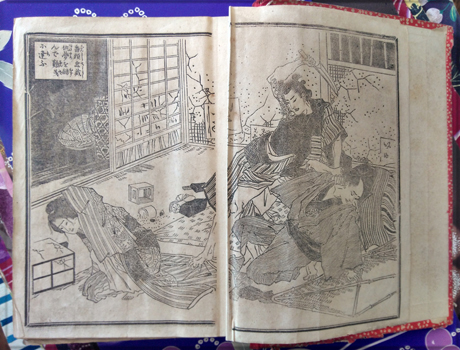
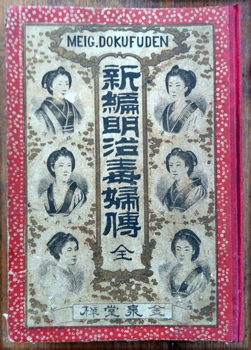
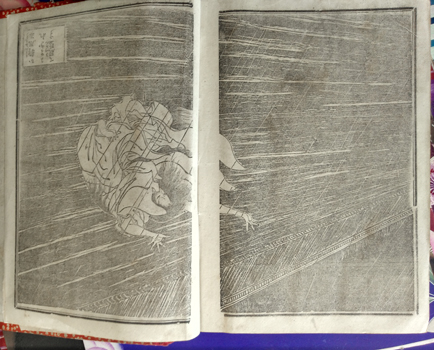
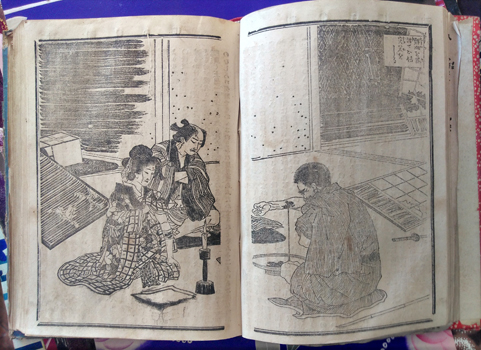

Suzuki Kinjiro. Meig. Dokufuden - [Shinpen Meiji Dokufuden]. Tokyo, Kinsendo 1887 [Meiji 20]. 18x13cm publisher's cloth backed illustrated boards (edges worn); one single page and several double page illustrations. Inner front hinge separated, inner back hinge cracked; maybe missing the front endpaper and the first two leaves (illustrations) are creased; two leaves sprung. A read copy I'm sorry to say, but for one of these flimsy board books made to be read to pieces, still acceptable. Au$150
Second edition? But how many were there? First published in December 1886 this copy is dated November 1887 but is a different book from the copy of the same date illustrated by the NDL. Starting at the front: the cover has been redrawn, the contents are a different printing with different pagination, in a different order and the illustrations are not all the same. The pagination is a nightmare; it starts, stops, jumps forward and back and nowhere meets the NDL November 1887 copy until we get to the last page.
One the prizes of the dokufu craze of the early Meiji. dokufu - poisonous women - are nothing new of course but the happy conjunction at the advent of mass circulation newspapers of a beautifully timed series of murders by unvirtuous young women set the sensation mongers and their readers all of a fever. Newspaper to book, lurid print to kabuki and back again, dokufu were all the rage for a couple of decades. Along the way crime fiction was born and, in a way, modern Japanese literature.
This went to press too soon for Hanai Oume - 1887's murderess of choice - but I don't doubt her case sparked this new edition; she was sentenced in November. Takahashi Oden, Yoarashi Okinu, Torioi Omatsu, Gonsai Otatsu, Ibaraki Otaki and Kaminari Oshin provide plenty to go on with.
Worldcat finds no copies of any but a modern reprint outside the NDL and it was some consolation to see that this copy is a lot better than one reproduced online by the NDL.
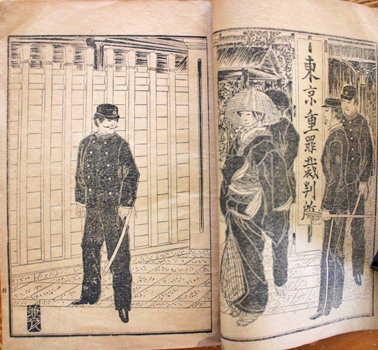
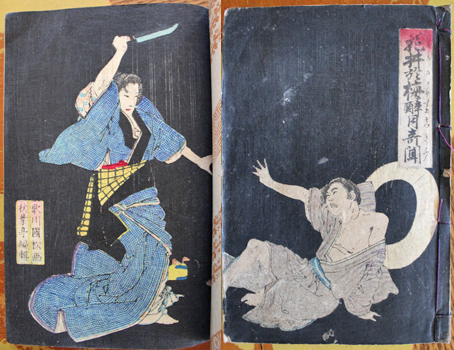
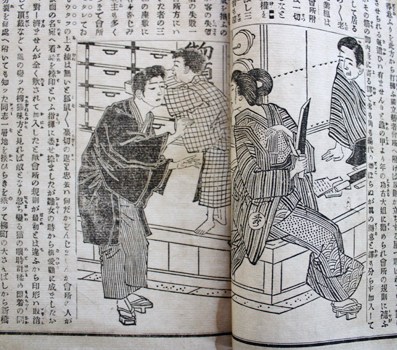
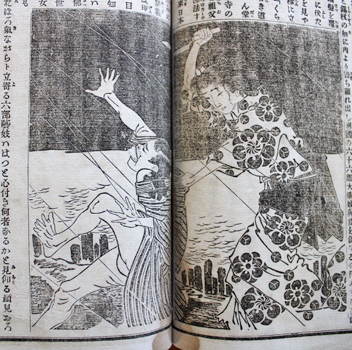

Hanai Oume. Shuyotei Sofu. [or ] [Hanai Oume Suigetsu Kibun]. Tokyo, Ishikawa Denkichi December 1887 (Meiji 20). Two volumes stitched together 18x12cm, colour wood covers by Utagawa Kunimatsu (the first a bit used with a small hole); two double page, two single illustrations at the front, four large illustrations through the text. Browning of the preliminary pages of volume one, a stain in the gutter at the bottom, still rather good. Au$350
One of the prizes of the dokufu craze of the early Meiji. dokufu - poisonous women - are nothing new of course but the happy conjunction at the advent of mass circulation newspapers of a beautifully timed series of murders by unvirtuous young women set the sensation mongers and their readers all of a fever. Newspaper to book, lurid print to kabuki and back again, dokufu were all the rage for a couple of decades. Along the way crime fiction was born and, in a way, modern Japanese literature.
Hanai Oume earned her place as one on the trinity of great dokufu for the murder of her employee for helping her sponging father muscle her out of her business - the teahouse Suigetsu. The famous umbrella was part of her defence.
Of course nothing about cheap popular trash like this is going to be straightforward. The colophon here tells us this is a reprint but lists the first as November 1887 which must be a newspaper appearance. Keio university's copy which uses the same covers is a different printing from a different publisher (Mizuno Ikutaro) with a colophon listing nothing before December while Yamanashi University's copy, published by Yamazaki Matasaburo and dated the same day as Keio's, is yet another different printing with a different cover. None of this is helped by the book being titled by both variants in the same copy.
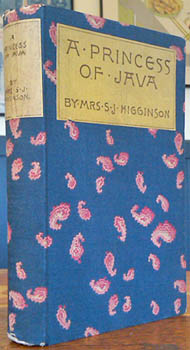
HIGGINSON, S.J. [Sarah Jane Hatfield Higginson]. A Princess of Java. A tale of the far east. Boston, Houghton Mifflin 1887. Octavo publisher's printed pattern cloth with paper labels (spine tips a bit chipped). Au$175
First edition of this sometimes thrilling romance, or sometimes romantic thriller. I can't decide whether Mrs Higginson ever visited Java. This begins more like a travelogue - and she wrote a travel book for children about Java a few years later - than a novel and it's the surfeit of local colour and language that makes me wonder whether it all comes out of Raffles.
There is a strong streak of feminism. Our heroine princess, infected by association with western women, rejects docile subjection to her arranged marriage and other distasteful traditions but the extraordinary culmination of this book is the celebration of not one but two interracial marriages. Admittedly the duskier half of each couple is the princess and a handsome young prince and the unions eventuate with some fairy tale inevitability. But the ordeals and dangers, the adventures of the heroines (there are three) are directed by their conflict with the cultural and racist demands of their parents.
In the end it's Mrs Higginson's brave appreciation of and close attention to the beauty of the Javanese that lends me to believe she spent time there; more than her cavalcade of murderous amok, Guwa Upas - Valley of Poison - and ular lanang, a king cobra that blows gusts of poison.
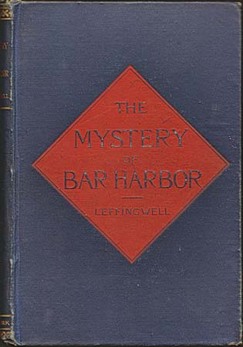
LEFFINGWELL, Alsop. The Mystery of Bar Harbor. A melo-dramatic romance of France and Mt. Desert. NY, Dillingham 1887. Octavo publisher's cloth blocked in gilt and black (a touch rubbed); some natural browning but quite a good copy. Au$145
First (only?) edition. Melo-dramatic indeed, with a kidnapped princess carried off from France to Maine, and a not cliff-hanger but open ending suggesting there might be a sequel. Though it's hard to see more than a short chapter. Not only is there no sequel but, as far as can be ascertained, no other book of any sort.
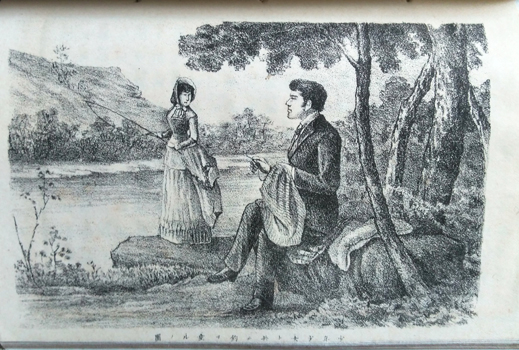
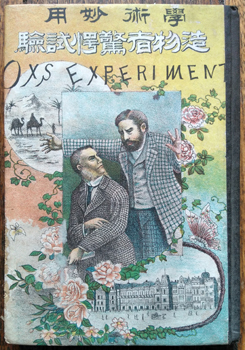

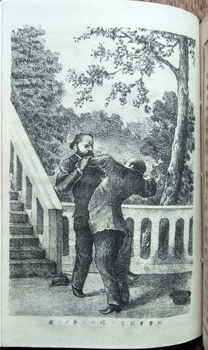

VERNE, Jules and Inoue Tsutomu. : [Gakujutsu myoyo : Zobutsusha kyogaku shiken]. Tokyo, Kochisha 1887 (Meiji 20). 18x12cm, publisher's cloth backed colour illustrated boards; [6],142pp, four litho plates. A touch of surface nibbling to the front edge of the front cover, some natural browning of the paper; an outstanding, obviously unread copy. Au$850
First edition. A translation from Dr. Ox's Experiment - the English version of Fantaisie du Docteur Ox. Inoue was a busy translator with a specialty in Jules Verne and I wonder how he handled Verne's extended mockery of the Flemish. Not that the Japanese haven't mastered regional insult, but how aware was he that this is pretty much the whole novel? Did he give his characters a Kansai accent?
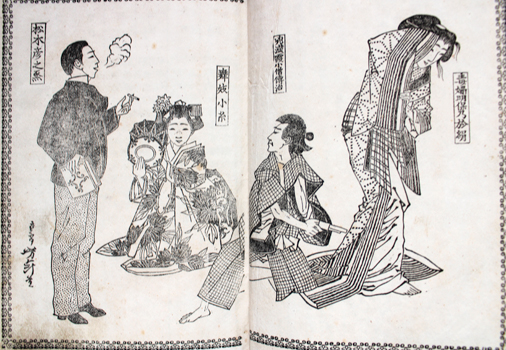
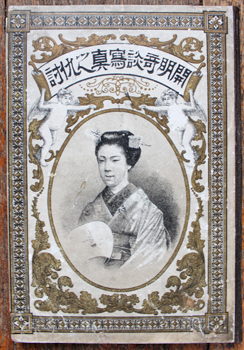
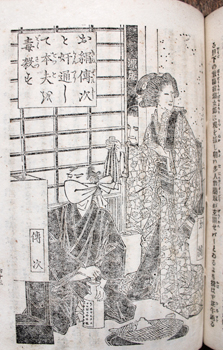

Gomeiro Tamasuke & Ito Senzo [Kaimeikidan Shashinnoadauchi]. Tokyo?, Hiyoshido 1887 (Meiji 20) 19x12cm publisher's cloth backed colour illustrated boards; 100pp, one double page, four full page illustrations. Smudges and minor signs of use, rather good. Au$350
A murder mystery revenge tale in which a photograph both identifies the killer and can curse that killer. Stabbing portraits has a long history in the west but usually in fury, for wish fullfilment and, in a few cases, as practice for the real thing. Witchcraft didn't come into it. As far as I'm aware using a portrait to curse someone was not much of a thing in Japan, there were plenty of other ways. And photographs? Is there any earlier use of photos to curse someone?
This is a reprint; it first appeared, I think, in 1884 in two parts. It is a sokkibon, a stenographic book, from a story told by Gomeiro transcribed by Ito. And it's a 'ball cover' (boru hyoshi) book - a symbol of modernity and the Japanese equivalent of a yellowback: flimsy western style bindings with lithograph covers that rarely survive in decent shape. Worldcat finds no copies of any edition outside Japan.
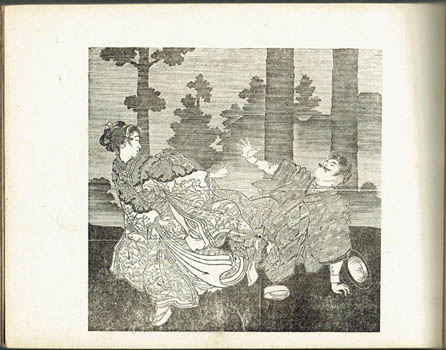
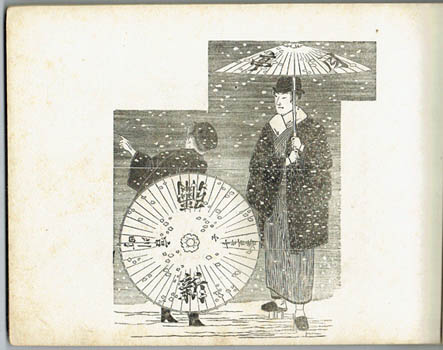
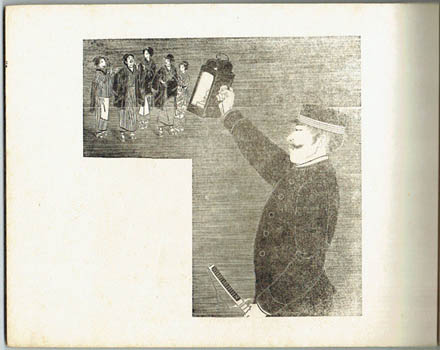
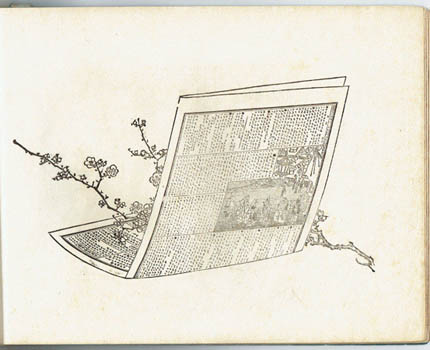

Dokufu. Hanai Oume? Set of proof wood engraved illustrations for a Japanese serial story. n.p. n.d. [c 1887?] 19x26cm, contemporary plain wrapper; 41 wood engravings on 21 double folded leaves. A little browning. Au$475
A prime example of the strange casserole of Meiji Japan. In form, in technique, in content and in production these hold all the paradoxes of Japan embracing western modernisation while hanging fast to tradition. These are the illustrations for what seems a rollicking sword and sash thriller but ... it is set in a modern metropolis; bowler hats, suits and dashing mustachios are not out of place, neither is what looks like a railway station. And these are not ukiyo-e woodcuts for a popular novel, these are western wood engravings for a long serial - there are 41 after all - in a newspaper or broadsheet magazine; an illustration of such a paper helpfully holds a bough of blossoms in one illustration. The subject apart, the glaring difference between these and any western illustrations is the skill of artist and engraver, all but a few western counterparts are put to shame.
I'm convinced that these relate to Hanai Oume the celebrated Tokyo geisha-teahouse owner who, in 1887, stabbed her employee who, apparently in concert with her father, was trying to muscle her out of the business. The first illustration here shows two men holding umbrellas that, I'm told, advertise a restaurant or 'licenced pleasure quarter' remarkably similar to hers: Suigetsu. The umbrella was part of her claim of self defence: Minekichi attacked her with the knife, she disarmed him with her umbrella and then stabbed him.
Oume or O-ume - her professional name - was celebrity manifest, one of the three most famous dokufu (poisonous women) of the Meiji. Her murder trial was public and, though crowds unable to get in became irate, every moment was covered in the press; books were published within minutes, kabuki plays and novels performed and published, and the newspapers made rich. Yoshitoshi produced a famous print of the murder as a supplement for the Yamato Shimbun but while there is plenty of violence in these pictures there is no murder. Spin-off or fanciful concoction, there's a good story here.
There is an owner's (maybe artist's?) seal which I make out to be 春耕慢虫 - I'm sure I'm wrong.
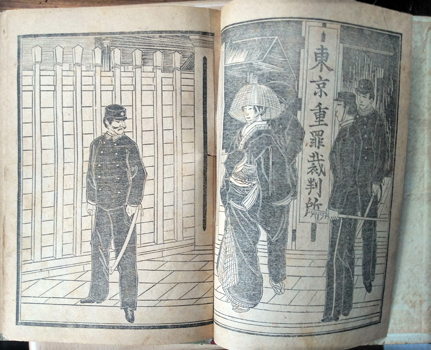
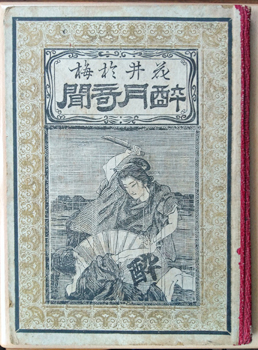

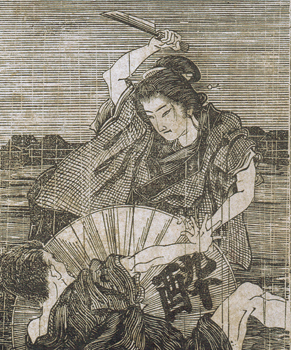

Hanai Oume. Shuyotei Sofu. [or ] [Hanai Oume Suigetsu Kibun]. Tokyo, Mori Senkichi 1888 (Meiji 21). 18x13cm, publisher's cloth backed illustrated boards; one double page and two full page illustrations; 72pp. The cheap paper browned; a rather good copy of a book made to be read to death. Au$250
One of the prizes of the dokufu craze of the early Meiji. dokufu - poisonous women - are nothing new of course but the happy conjunction at the advent of mass circulation newspapers of a beautifully timed series of murders by unvirtuous young women set the sensation mongers and their readers all of a fever. Newspaper to book, lurid print to kabuki and back again, dokufu were all the rage for a couple of decades. Along the way crime fiction was born and, in a way, modern Japanese literature.
Hanai earned her place as one on the trinity of great dokufu for the murder of her employee for helping her sponging father muscle her out of her business - the teahouse Suigetsu. The famous umbrella was part of her defence.
Of course nothing about cheap popular trash like this is going to be straightforward. The Strange Story of Hanai Oume at Suigetsu was first published in December 1887, just after her murder trial in November, in two volumes. Our edition appeared in December 1888 and who knows how many came in between. NDL records the December 1887 and a November 1888 printing and nothing else and I can't find anything elsewhere.

BROCK, R.W. [ie John Alexander Barr]. Mihawhenua: the Adventures of a Party of Tourists Amongst a Tribe of Maoris Discovered in Western Otago, New Zealand. Recorded By R. W. Brock, MA, LLB. Edited By R. H. Chapman. (Being a Manuscript Addressed to the Editor, Found Attached to a Maori Kite on Mount Alta ... Dunedin, Wilkie & Co 1888. Octavo publisher's illustrated wrapper (spine chipped); 198,[2 adverts]pp. Used but a very decent copy. Au$600
A lost race thriller with the race being discovered in a lush world around a warm lake hidden in the mountains. Barr published a few novels all in a rush, including two thrillers - one Australian - under the name Gilbert Rock but his own story is perhaps more exciting than Moa riding Maoris, cannibals, and treacherous French sailors. A Dunedin lawyer, he petitioned in 1888 for a protective tax on all imported literature, assuring the government that he was "prepared to supply the colonial market with literature if inducement offers." All his known novels then appeared by November.
Soon after he did 'the Pacific Slope' (a great term I hadn't heard before), abandoning his family and absconding with many thousands of his clients' pounds either lost or in his pocket. Here Barr vanishes from view except for a startling piece in the Auckland Star of October 1 1894 in which is mentioned a letter just received by Sir George Grey from the author of Mihawhenua with a return address but an indecipherable signature. No-one could decipher the signature so Grey's secretary cut the signature from the letter and pasted it onto the reply. No connection was made between the author of Mihawhenua and the missing lawyer. A final glimpse is a London death notice in 1907 which identifies him as a former solicitor of Dunedin and tells us he has been living in England with his wife and family for five or six years. I wonder if it was the same family.
The dedication, to the colonial press in "grateful acknowledgment", of one of his thrillers, 'By Passion Driven', was declined on conscientious grounds by the Christchurch Telegraph who said, "What object Mr Gilbert Rock could have had we do not know". Perhaps his dedication was for The Daily Telegraph who described his 'Colonists' as "not a badly told story".
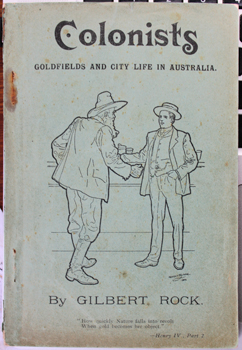
ROCK, Gilbert. [ie John Alexander Barr]. Colonists. Illustrating goldfields and city life in Australia between 1851 and 1870. Dunedin, Wilkie & Co 1888. Octavo publisher's illustrated wrapper; 152pp. Staple stains and minor signs of use; a rather good copy. Au$800
A later issue of the first edition of this rare thriller - the wrapper illustration is dated 1906. A lousy title but replete with murder, revenge, conspiracy ... and I'm only reading from the chapter titles. The misleading title no doubt helped this being well represented in Australian libraries and led to Ferguson recording it, cementing its rarity now. This was published in London, Toronto and in New York (in the Magnet Detective Library) as The Mystery of Golden Gully which barely exist in libraries. Gilbert Rock was missed by Loder.
Barr published a few novels all in a rush, including two thrillers under the name Gilbert Rock and his lost race thriller Mihawhenua under the name Brock but his own story is perhaps more exciting. A Dunedin lawyer, he petitioned in 1888 for a protective tax on all imported literature, assuring the government that he was "prepared to supply the colonial market with literature if inducement offers." All his known novels then appeared by November.
Soon after he did 'the Pacific Slope' (a great term I hadn't heard before), abandoning his family and absconding with many thousands of his clients' pounds either lost or in his pocket. Here Barr vanishes from view except for a startling piece in the Auckland Star of October 1 1894 in which is mentioned a letter just received by Sir George Grey from the author of Mihawhenua with a return address but an indecipherable signature. No-one could decipher the signature so Grey's secretary cut the signature from the letter and pasted it onto the reply. No connection was made between the author of Mihawhenua and the missing lawyer. A final glimpse is a London death notice in 1907 which identifies him as a former solicitor of Dunedin and tells us he has been living in England with his wife and family for five or six years. I guess it was the same family. So, it it a coincidence that this was reissued at about the time that news of his death reached Wilkie & Co?
The dedication, to the colonial press in "grateful acknowledgment," of his thriller, By Passion Driven, was declined on conscientious grounds by the Christchurch Telegraph who said, "What object Mr Gilbert Rock could have had we do not know". Perhaps his dedication was for The Daily Telegraph who described his Colonists as "not a badly told story".
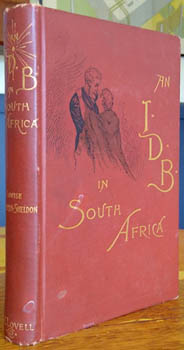
VESCELIUS-SHELDON, Louise. An I.D.B. in South Africa. NY, Lovell [1888]. Octavo publisher's illustrated cloth (a couple of small spots); illustrations through the text. Minor signs of use but a good, bright copy. Au$125
First edition, there was a London issue using these sheets. I don't want to give away too much but this is complicated. We begin in a theatre box in the Kimberley diamond fields with Herr Schwatka divulging to a near stranger that the fascinating beauty in the box opposite has Zulu blood. Before the end of this short chapter Count Telfus has been arrested in that same box for having an illicit diamond (IDB is an illicit diamond buyer), handcuffed, locked up and has shot himself in his cell. The South African police frisk prisoners for diamonds, not guns. Donald Laure worships his part Zulu wife Dainty but has a guilty secret or two while she has not yet had the passion in her soul awakened. But she does have a black dwarf servant with a glass eye.
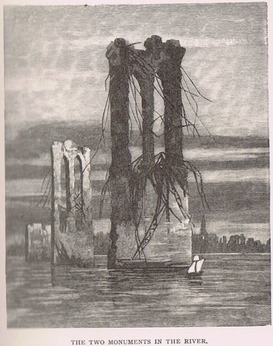
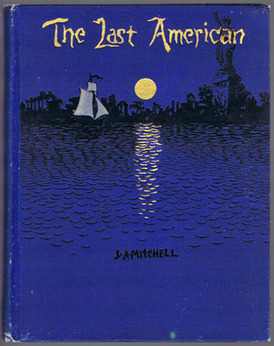
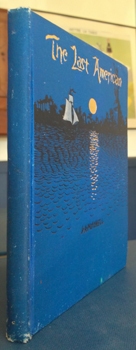

MITCHELL, J.A. The Last American. A fragment from the journal of Khan-Li, Prince of Dimph-yoo-chur and Admiral in the Persian Navy. NY, Stokes 1889. Octavo publisher's dark blue illustrated cloth blocked in black and gilt (tips rubbed); 78pp, illustrations. A couple of minor flaws and signs of use but a pretty good copy. Au$175
First edition of this amusing (if pun spattered) account of a voyage of discovery to the ruins of Mehrika at the end of the 30th century; it is filled with anthropological and archaeological revelations. The street scene showing daily life in ancient Nhu-Yok is particularly good. The end is sad.
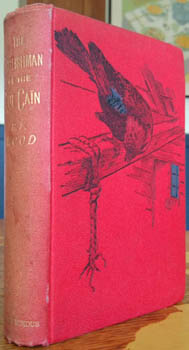
WOOD, H.F. [Harry Freeman]. The Englishman of the Rue Cain. London, Chatto & Windus 1889. Octavo publisher's illustrated cloth blocked in black and grey (spine faded and a bit rubbed). Publisher's catalogue for October 1888 at the end. Canted but rather good and fresh inside. Au$135
First edition of this murder mystery set in Paris involving a missing heir, cross dressing villains, a cavalcade of detectives and all manner of complications. Wood's second mystery after The Passenger From Scotland Yard the year before. The Spectator surprises by beginning their review most favourably but are more characteristic by the end: " a really clever novel; its detective elements are good; but the story ... has a certain air of incoherency."
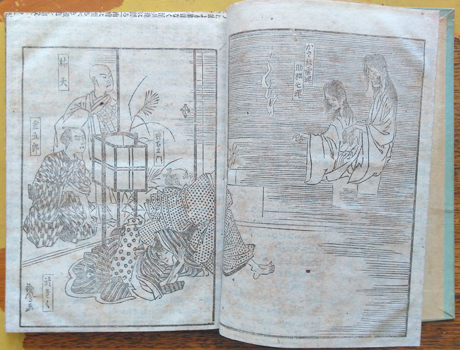
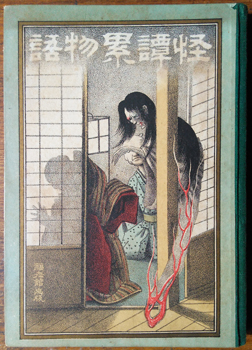
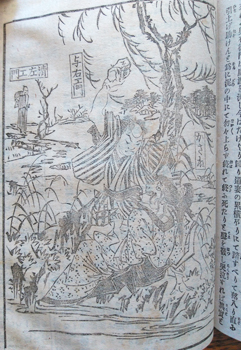
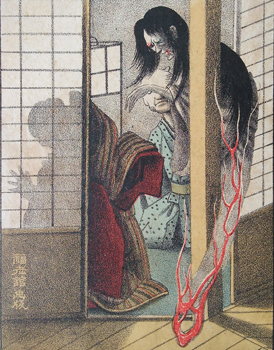

Yanagisawa Bunzo &c. [Kaidan Kasane Monogatari]. Osaka, Konomura Shosuke 1889 (Meiji 22). 18x13cm publisher's colour lithograph boards with cloth spine; [4],56,[2]pp on double folded leaves, one double page and four single page illustrations. Mild browning, a pleasing fresh copy. Au$500
First edition of this version of the Kasane ghost story, a story that bulges with murder, greed, curses, possession and guilt. Supposedly based on a true story the saintly monk Yuten stars as the exorcist, and was the inspiration for prints, books, rakugo, kabuki and film.
The double leaves seemed a bit extravagant for a book like this but all the paper is re-used from some other job with printing on the other side. This is a 'ball cover' (boru hyoshi, apparently a corruption of 'board') book - a signal of modernity and the Japanese equivalent of a yellowback: flimsy western style bindings with lithograph covers that rarely survive in such good shape. Worldcat finds only the NDL entry and a search of CiNii found no more.

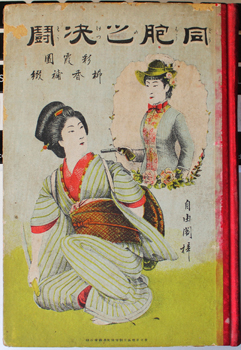
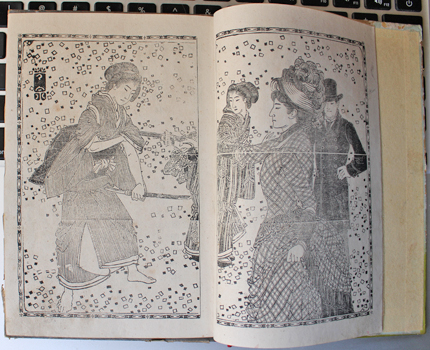
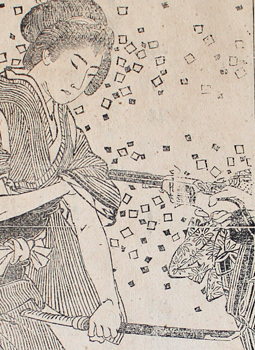

Gyokaen Karyu & Saikaen Ryuko. [Doho no Ketto]. Tokyo, Jiyukaku 1889 (Meiji 22). 18x12cm publisher's cloth backed colour illustrated boards (a touch of nibbling around the edges); one double page, sixteen single page and two half page illustrations by Arai Yoshimune. A rather good copy. Au$200
First edition of of this modern thriller. I have little clue of what happens but when a well dressed - a la the west - young woman totes a revolver onto the front cover and faces a sword toting young woman in Japanese dress ... well, what more is there to say? The title more or less translates as 'Compatriots' Duel'. It was reprinted a few years later with a better title, Duelling Beauties (Ketto Bijin).
This is a 'ball cover' (boru hyoshi, apparently a corruption of 'board') book - a signal of modernity and the Japanese equivalent of a yellowback: flimsy western style bindings with lithograph covers that rarely survive in such good shape.
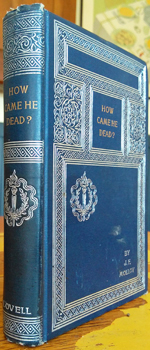
MOLLOY, J. Fitzgerald. How Came He Dead? NY, Lovell [1890?]. Octavo publisher's decorated cloth blocked in silver and gilt. Cover a touch marked, stitching a bit loose; quite good. Au$300
First edition, it seems, of a now obscure and rare thriller that may well be among the most widely read novels in late colonial Australia. I don't say it was a best seller - I find no evidence that any copy of this book ever reached Australia - but it was serialised in newspapers in, at least, Brisbane and Gippsland and likely in provincial papers yet to be unearthed. It was also serialised in at least one New Zealand paper and in the US, which is presumably how Lovell got hold hold of it.
This is an English tale of modern villainy populated by London society and ornamented with an Irish dungeon, mysterious Indian poisons and brazen coincidence. In all, satisfying verandah reading from Queensland to Victoria. Other Molloy syndicated serial thrillers did make it to book form in England but I can't discover that there was ever an English edition of this.
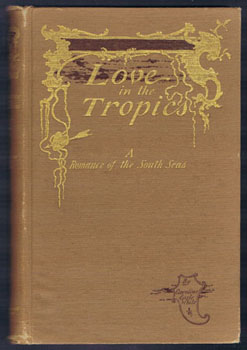
WHITE, Caroline Earl. Love in the Tropics. A romance of the south seas. Philadelphia, Lippincott 1890. Octavo publisher's decorated cloth (spine a bit dull and rubbed). What looks like a smear on the front cover is part of the design. Au$85
Only edition. A Pacific thriller that sees a shipwrecked sailor cast ashore on an imagined island somewhere near Tonga where love, treachery and murder are almost overshadowed by the man eating Kaukevara Tree.
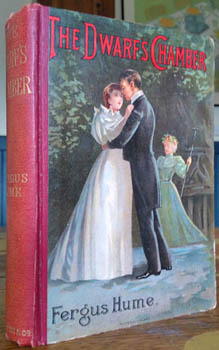
HUME, Fergus. The Dwarf's Chamber. London, Ward Lock [189-?]. Octavo publisher's colour illustrated glazed boards with cloth spine (this a touch faded); illustrations by Percy F.S. Spence and others. The title page - on cheaper paper - a bit browned, a bit of a lean, a little wear to corners and edges, a rather good copy. Au$185
A re-issue of the original 1896 sheets with a cancel title page and part of the appealing Ward Lock 2/- Copyright Novels series. This is the copy illustrated in John Loder's survey of the 2/- series. This is sort of intriguing as an exercise in marketing. The "other stories" - ie The Dwarf's Chamber and Other Stories as it was first titled - have been dumped - from the title, not the book. Perhaps a glut of short story collections on the market. The Dwarf's Chamber is the longest by far piece in the book but there are some other useful titles in there: Dead Man's Diamonds - too many diamonds in the thriller market ... Tale of the Turquoise Skull - too obvious a short story ... the Green-Eyed God and the Stockbroker - again too obvious as is the Ivory Leg and the Twenty-Four Diamonds - and there's diamonds again.
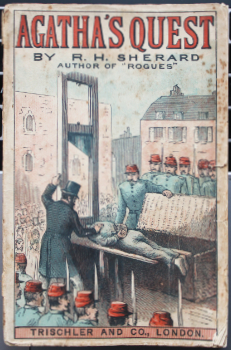
SHERARD, R.H. [Robert Harborough]. Agatha's Quest. London, Trischler 1890. Octavo publisher's colour illustrated wrapper (frayed, spine chipped). Fairly used, with some dog ears and browning at the beginning but all solid and respectable enough for a cheap thriller. Au$300
Doubtless the first edition despite being called the "fifteenth thousand". This was the usual way Trischler puffed new books without downright lying. The number was their print run based on pre-orders. Trischler was a short-lived firm. They began as the Hansom Cab Publishing Company with Hume's masterpiece, morphed into Trischler and were dead by 1892.
A sensational mystery thriller starring a woman jornalist; something that impressed Jules Verne so much that he contributed a prefatory letter about this new subject for fiction, assuring Sherard of success. This in turn impressed George Locke so much that he was eager to add this unknown B item to Verne's bibliography (Spectrum v3).
Agatha's Quest annoyed the Saturday Review critic, the only review I've found: "It is highly improbable that so transcendent a genius as Agatha would have married the comsumptive cur who turned out to be a murderer; nor would she as a newspaper-woman have given up her "assignment" in America for the weak reasons allotted. The author has decidedly primitive ideas about people who let lodgings; ... also it may be usual for aggressive strangers who wear disguises, and who shriek horribly upon awaking, to address their landladies by their Christian names ..."
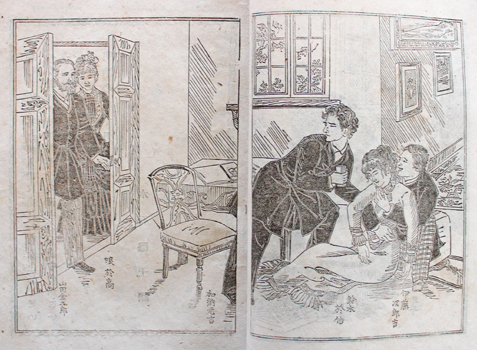
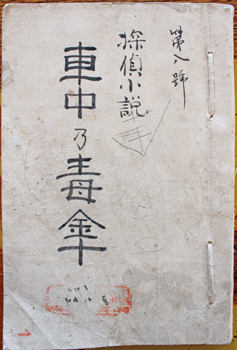
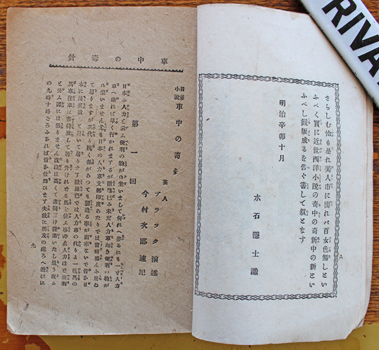
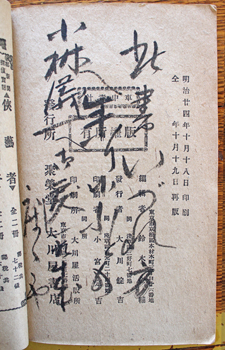

Henry James Black. (Burakku Kairakutei). Du Boisgobey, Fortune. : [Shachu no dokubari : Tantei shosetsu]. Tokyo, Okawa 1891 (Meiji 24). 220x145mm, without original wrapper in a later but old light card wrapper lettered by hand; 190,[4 advert]pp; 11 double page illustrations. Brushed inscription over the colophon page, certainly read, natural browning of the paper but a respectable enough and solid copy. Au$650
A detective story told as a serial to an audience by a gay Australian who became a professional Japanese story teller and actor, taken down in shorthand and published as this book.
Black was born in Adelaide and arrived in Japan in 1865 at the age of almost seven - his father, up until now a singer, had bought into the Japan Herald. Henry seems to have grown into something of a no-hoper in the eyes of some of his family at least and rather than settle to respectable work became first a proponent of progressive reform, like his father, then a professional rakugoka - story teller - and even a kabuki actor playing women. His reaction to his siblings' disapproval was to change his name to Burakku Kairakutei (Pleasure Black), marry a Japanese woman and become a Japanese citizen.
Ian McArthur, Black's biographer, quotes from a police report made at this time that he was living in "virtually a husband and wife relationship" with a young Japanese man but otherwise there was nothing untoward to worry about. At the height of his fame - 1891 and 92 - maybe six or seven of these stenographic novels were published and other stories appeared in newspapers. It's a bit hard to unravel as a couple appeared more than once with different titles. Even the concise and acerbic Edogawa Rampo gets muddled and misled trying to work out a bibliography at the end of his 1951 essay translated as 'Fingerprint Novels of the Meiji Era'. He cites another essayist who wrote on Black and said he had five of his books, Rampo had only three.
This handful of detective stories or thrillers was bracketed by two translations or adaptations of novels: Mrs Braddon's Flower and Weed in 1886 and Dickens' Oliver Twist in 1895. Of the thrillers from these two boom years, two are known to be adapted from stories by Mrs Braddon and one - this one - from a story by Fortune du Boisgobey. Boisgobey's 'Crime de l'Omnibus' appeared in 1881 but Black was much more likely to work from a cheap English translation published in New York in 1882 or by Vizetelly in 1885 - titled 'The Mystery of an Omnibus' and 'An Omnibus Mystery' respectively. I like Black's title better which translates more or less as The Poisoned Needle in the Coach.
These stenographic books - sokkibon - were hugely popular, distributed largely through lending libraries and have a pitiful survival rate. They are credited with playing a large part in transforming Japanese literature from the classical and formal to colloquial.
This is not the board cover edition, it is printed from what looks to be the same setting on larger, coarser paper with added running titles and was undoubtedly issued in wrappers. The colophon says that it was printed on the same day (October 19) as the original which could, I guess, be true. Worldcat, when nudged, finds two entries - both the board edition - the NDL in Japan and the NLA in Australia.
  1 [2] 3 4 5 1 [2] 3 4 5   |